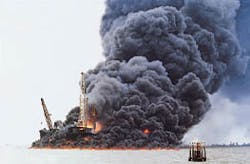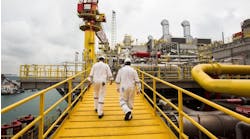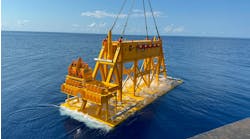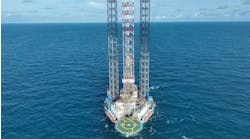Unlike this nearshore blowout, a subsea blowout in 7,500-ft waters may be more than the industry is ready for at this time.
Deepwater well control
Drilling holes through a seafloor beneath thousands of feet of water is the easy part. Turning holes into viable oil and gas wells in ultradeep waters, however, still pose a few technological challenges. With current riser technology for instance, it is impossible to reach most formations with a wellbore of sufficient ID to accommodate production rates high enough to make such projects economical in waters beyond about 7,500 ft.But more immediately (the riser quandry is well in hand) there exists the troubling question of well control in a blowout situation.
Boots & Coots' engineering manager, Larry Flak, is a frequent contributor to Offshore Magazine and a ponderer of such problems. Among other things occupying Flak's attention these days is the question of just what equipment will be used to fight a sustained, deepwater blowout. After all, every rig capable of working in such depths is. Likewise obtaining sufficient riser on short notice is more than a little problematic even if the rig on location escaped the blowout unscathed and in working order.
"That [equipment shortage] is not going to change," Flak said. "You can't keep a rig sitting around waiting for a blowout. But the operators should be talking about it now."
Shutting down a drilling rig in order to assist a company in a time of extreme trouble is an expensive gesture and an awful lot to ask of a friend much less a competitor. But it is a gesture the industry probably must be ready to make if it expects the general public to trust it to mine the resources beyond the continental shelves.
As the oil industry should have learned by now, the general public and those bodies with regulatory powers over it, view the industry as a monolith - what involves one oil company involves them all. It can only benefit the industry to deal with this problem openly and to include all players - operators, service companies, well control professionals, and governments. If such a dialogue has begun, many in the industry haven't heard of it.
Flak is also thinking and talking about more than dialogues over scarce equipment. The most common technique for dealing with sustained blowouts - drilling a relief well - comes with its own set of drawbacks in deep water. Most notable, he said, is the rates necessary to kill a well, a virtual impossibility through typical 3-in. kill and choke lines in deep water. In short, traditional dynamic kills are not going to happen in deep and ultradeep water. Flak will offer an alternative, lower-rate solution to that particular dilemma in an article to appear in a later edition of Offshore.
Environment, safety, and reality
Anyone who has been victimized by it knows all too well that correcting wrongs perpetrated by simplistic reporting is like trying to uncook a bad meal. Bob Bauer feels saddled with just that kind of task because of how the US government's Environmental Protection Agency has handled freon. Bauer is the marketing manager of US-based Buck Scientific. His company builds testers that use freon to calculate the level of hydrocarbons in flowstreams discharged over the sides of offshore drilling rigs."The EPA came along and said no more freon," Bauer said. "Then later quietly came back and said it was okay for scientific pur poses and have granted Dow and Dupont licenses to manufacture it."
That the EPA banned freon's use in the US was important news to the population of a nation whose ubiquitous air conditioners run on the stuff. Unfortunately, their conditional reversal earned freon no ink at all and freon remained in the public conscience a substance akin to asbestos.
Buck Scientific's and others' testers use infra-red or gravitometers to measure hydro carbon contamination of fluids. Infra-red, which uses Freon-113 to extract hydrocarbons from the test subject, is considered by many to be the better method.
Available from several large distributors, most drilling units go through about a gallon of the stuff per year, of which, Bauer said, they will recapture and recycle 95% - 97%.
The alternative currently being touted
by those wishing to consign freon to chemical oblivion, including some oil company scientists, is hexane. It leaves some things to be desired, including that while not painted by the broad brush of being an ozone threat, it doesn't work as well as freon. The trade-off would then seem to devolve to the environmental risk from missed hydrocarbons vs. that from .03 gallons of freon per year released into the atmosphere.
The real damage done by either scenario is being debated in scientific and pseudo-scientific forums worldwide. Less open to question, believes Bauer, is the risk posed by a gallon or more of highly explosive hexane on board any ocean-going vessel. As anyone who has been there will attest, nothing strikes fear in a crew's heart as does the threat of fire at sea.
Safety and environmental responsibility have rightly become sacred chants on board offshore drilling rigs and in the offices from which they are run. It would seem something of a step backwards to replace an efficient, safe, and recyclable material with one that appears to be none of those things.
Biodegradable drilling fluids
The British journal, New Scientist, reports that scientists at Edinburgh's Heriot Watt University are turning to VOODOO to find a biodegradable oil for use in drilling muds. The unscientific sounding acronym stands for Vegetable Oil for Offshore Drilling Operations and is a very scientific attempt to use rapeseed oil as a replacement for the mineral oils currently being used and dumped with drill cuttings on the ocean floor.The three-year old project, with the help of Enterprise Oil, has established that the vegetable oil, similar to that used for cooking, remains an effective lubricant at temperatures of up to 120 deg C and pressures of 300 atmospheres.
Rapeseed oil's main attraction, of course, is that drill cuttings contaminated with it do not threaten marine life. Real-world trials in the North Sea are expected to take place sometime later in the year.
It is estimated 250 tons of rapeseed will be consumed per well drilled at a cost of about 450 pounds sterling per ton. About a ton of the stuff is produced per hectare of rapeseed and with about 50 wells to be drilled in the next year, the breakthrough could be something of a boon to UK farmers. The higher cost of rapeseed oil - mineral oil is about 300 pounds sterling per ton - is unlikely to dampen ecologists' enthusiasm for the product nor serve as a sufficient argument against it.
Copyright 1997 Oil & Gas Journal. All Rights Reserved.



